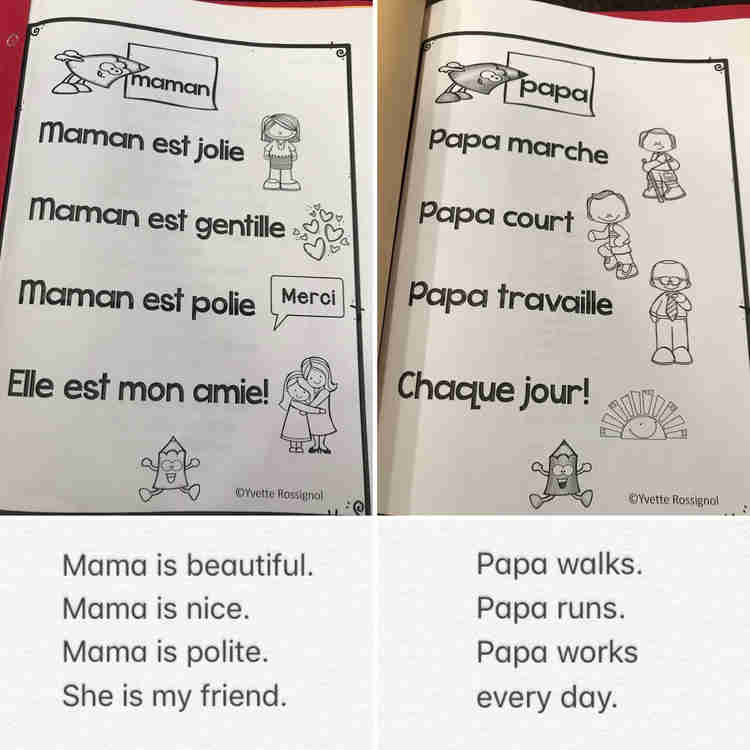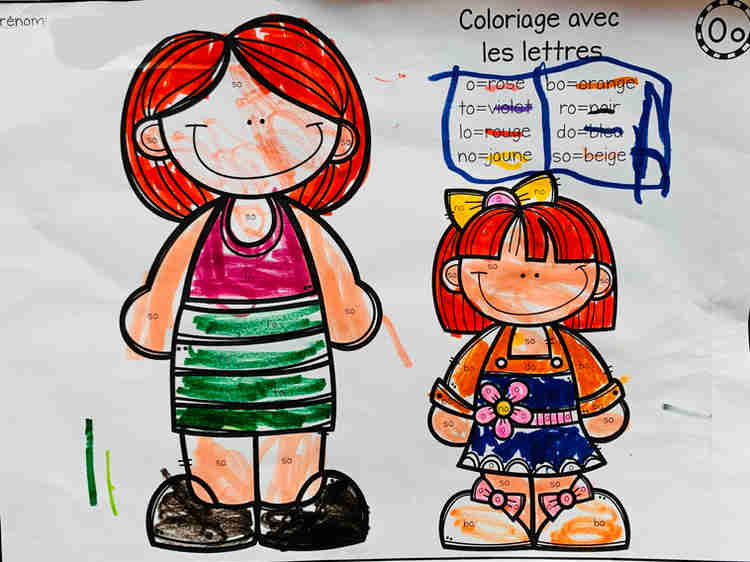We are fortunate to live in a city where our school board offers French and English language instruction beginning in kindergarten. There are so many advantages to being multilingual, and I’m grateful that my daughter has access to this kind of education. When she brought home this pair of colouring sheets from her kindergarten class last year, I knew I needed to have a conversation with both my daughter and also her teacher.


My daughter and I sat down to examine these worksheets together. I asked her if her Maman walks, runs, and works every day (yes), and if her Papa is beautiful, nice, polite and a friend (yes). Then we wondered aloud together why the author of this worksheet would choose those words to describe Maman and Papa. We quickly came to the conclusion that all the descriptors (nice, polite, runs, works) could apply to both Mamans and Papas (and that some descriptors would apply to neither–for example, a Maman who is a wheelchair user might not run). I also reinforced that some families have just a Maman or Papa, and some families have two Mamans or two Papas, and some families have lots of Mamans and Papas.
Next, I emailed her teacher:
“Bonjour Madame Teacher,
**Child’s name** and I were reading together this weekend, and I was excited to see new French worksheets (they help me with my French too!)
You are an amazing teacher, and every day I’m so glad that **Child’s name** gets to learn from you. Its deeply unfair that teachers have to fund so much of their educational materials from their own pockets, so I know that these Yvette Rossignol worksheets might have been purchased with your own money. I can also imagine that it is really difficult to find useful and effective teaching resources in French.
The combination of the maman and papa worksheets reinforces gender stereotypes in a troubling way. Maman is described as polite, gentle, a friend, while Papa is described as active and moving (walking, running) and working. Our young children get these gender ideas reinforced in so many insidious ways that are harmful. I want our girls to see themselves as successful working professionals, and our boys to see themselves as gentle and kind. While a series of worksheets may seem innocuous, the cumulative effect of reinforcing gender stereotypes can be dangerous.
Is there a way for me to help you have access to resources that don’t include this kind of stereotyping? I don’t want to add to your already formidable workload! Are the worksheets available with the descriptors reversed? Is it possible to use the worksheets with two Mamans or two Papas?
Thank you for listening to our family’s concerns about this and for being such a fantastic educator. Merci! Sincerely, Parent”
Note the three important elements of this email:
1) I led with acknowledging how hard teachers work, how they regularly spend their own money purchasing materials for their classroom, and how much I appreciate her work.
2) I gave a concrete description of what I found problematic in the worksheet.
3) I offered to help with a solution.
I received a warm response from the teacher acknowledging my concerns, thanking me for pointing out the stereotypes perpetuated in them, acknowledging that it was sometimes challenging to find developmentally appropriate materials, and committing to do better. No more worksheets like this one came home that year.
********************
Fast forward to Grade 1. My daughter brings home this colouring worksheet.


The first thing I notice is that the skin color is designated as beige. I start thinking back on all the coloring sheets my daughter has brought home over her short school career. I couldn’t recall seeing many characters that were coded as Black, meaning the hair wasn’t consistent with Black natural hairstyles. Then I started thinking about what kind of message this worksheet sends to children: that whiteness is default, that whiteness is normal, that being Indigenous or racialized is being “the other” or outside of the norm. This sends our children harmful messages that lead to the development of bias.
We know that it is critically important that children see themselves reflected in their learning environment and materials. Ontario’s Education Equity Action Plan calls for inclusive education: “[to] support boards in implementing teaching practices, curriculum and assessment that are culturally reflective of and responsive to the students they teach, so that all students see themselves, and their own and their classmates’ lived experience, reflected in what and how they are learning.”
One way that parents can advocate for equitable and inclusive learning environments is to speak up when they observe their child’s learning materials upholding stereotypes or presenting whiteness as the default or as normal. Carefully examine the work your child brings home, and if you do not see the diversity of Canada’s population represented, including diverse ethnicities and race, gender identities and expressions, disabilities, religions, and family structures, have a conversation with your child’s teacher. Visit the classroom and look around–what do the posters on the wall, the books on the shelf, the learning materials look like?
“Dear Madame Teacher,
**Child’s name** and I were reviewing her work from the week together this weekend (she’s always so proud to tell me what she’s done during the week!)We feel so fortunate that **Child’s name** is in your class, and every day I’m so glad that she gets to learn from you. Its deeply unfair that teachers have to fund so much of their educational materials from their own pockets, so I know that these Lisa Nichols worksheets might have been purchased with your own money. I can also imagine that it is really difficult to find useful and effective teaching resources in French.
I know the class was working on the letter “o” this week, and the coloring sheet portraying two people was to help reinforce that learning (photo attached). The first thing I noticed about this colouring sheet is that the skin color is designated as beige. As I start thinking back on all the coloring sheets **Child’s name*** has brought home over her short school career, I don’t recall seeing many characters that were coded as Black, meaning the hair wasn’t consistent with Black natural hairstyles. I also don’t remember seeing many with religious headcoverings or disabilities. That got me thinking about what kind of message this worksheet sends to children: that whiteness is default, that whiteness is normal, that being Indigenous or racialized is being “the other”. This sends our children a harmful message that can lead to the development of bias and racism.
We know that all children should be able to see themselves reflected in the curriculum, in their learning materials, and in their learning environment. I wonder if a simple edit could be made to this worksheet to make the hair color “your choice” or to make the skin color “brown” (since all human skin is just a shade of brown)? I don’t want to add to your already formidable workload! Maybe I could help edit worksheets like these for you?
Thank you for listening to our family’s concerns about this and for being such a fantastic educator. Merci! Sincerely, Parent”
It is essential that white parents share in the work of making learning environments equitable and inclusive by disrupting existing practices. Just because we’ve always done something one way doesn’t mean that it is the best way or that we should keep doing it that way. That work of achieving equitable learning environments should not fall exclusively on the shoulders of parents whose children are being excluded from the learning materials, environment, and curriculum.
You can use these two emails as templates for speaking up in your own child’s class when you observe learning materials that incorporate stereotypes or perpetuate bias. If you have a story to share about how you’ve spoken out for a more equitable learning environment, leave us a comment!



